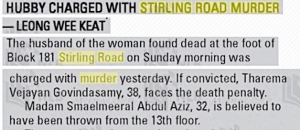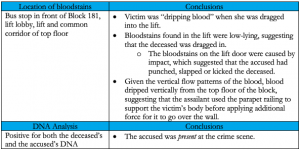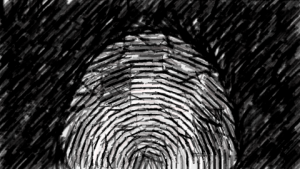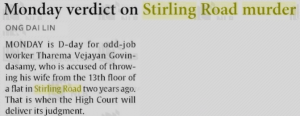CJC-F, CJC-F Announcements, CJC-F Case Commentaries, CLD Interest Pieces
CJC-F takes us through the use of blood analysis, fingerprinting, and odontology which ensured the accused’s conviction of murder.
IntroductionIn the early hours of 1 July 2007, the accused’s body was discovered at the ground of Block 181 Stirling Road. Paramedics pronounced her dead at the scene. Two days later, the accused surrendered himself to the police.

Facts
The night before her death, the deceased went drinking with her friends at a pub, staying there until 4 am. Around the same time, the accused contacted a mutual friend and told him that she was drunk. The friend then conveyed her message to the accused, whereupon the accused went to find the deceased.
On finding the deceased inebriated, the accused became angry and began to assault her. He dragged her to the top of Block 181 before causing her to fall over the parapet wall onto the ground below.

*AR + MR + Absence of Defence (AOD) = Conviction
Prosecution’s Forensic Evidence
The prosecution relied heavily on the autopsy, bloodstains, fingerprints and shoeprints to make its arguments.
Performed by Associate Professor Gilbert Lau (“Professor Lau”) of the Centre of Forensic Medicine of the Health Sciences Authority (“HSA”), the forensic pathologist found the following injuries (amongst others):

(2) Bloodstains
Forensic examination of the bloodstains and DNA analysis was conducted by Dr Tay Ming Kiong (“Dr Tay”) and Ang Hwee Cheng (“Mr Ang”) of the HSA respectively.
(3) Fingerprints and Shoeprints
Fingerprint analysis was conducted by Mohd Yazid bin Abdullah (“Mr Yazid”) while shoeprint analysis was conducted by forensic scientist Chow Yuen San Vickey (“Ms Vickey”).

Defence
Acknowledging the accused’s presence at the crime scene, the defence chose to focus on the general defence of intoxication and the partial defences of diminished responsibility and provocation. The defence further contended that the deceased committed suicide.
Judgment
From the very outset, Justice Tay Yong Kwang (“Tay J”) noted that positive blood swabs matching the accused’s DNA were found at the crime scene. This piece of forensic evidence was pivotal in placing the accused at Block 181 and its vicinity on 1 July 2007. It also proved that the accused had met the deceased.
In light of the damning forensic evidence and the inapplicable defences, Tay J thus convicted the accused of murder and sentenced him to the mandatory death penalty.
[Case Commentary written by Hariharan Ganesan]
*The views and opinions expressed in this article do not constitute legal advice and solely belong to the author and do not reflect the opinions and beliefs of the NUS Criminal Justice Club or its affiliates.

